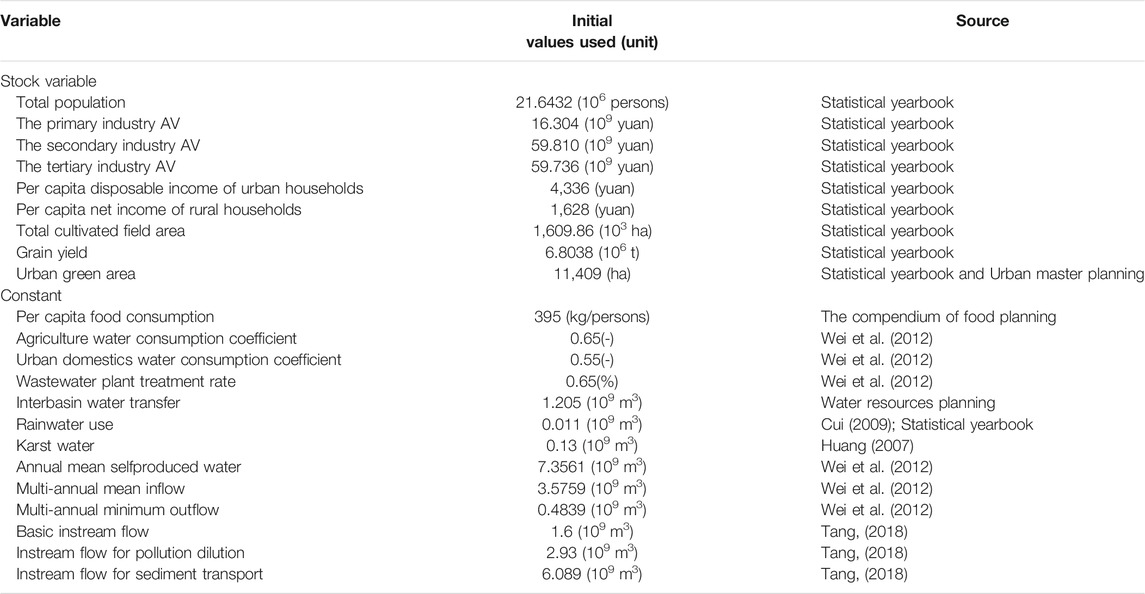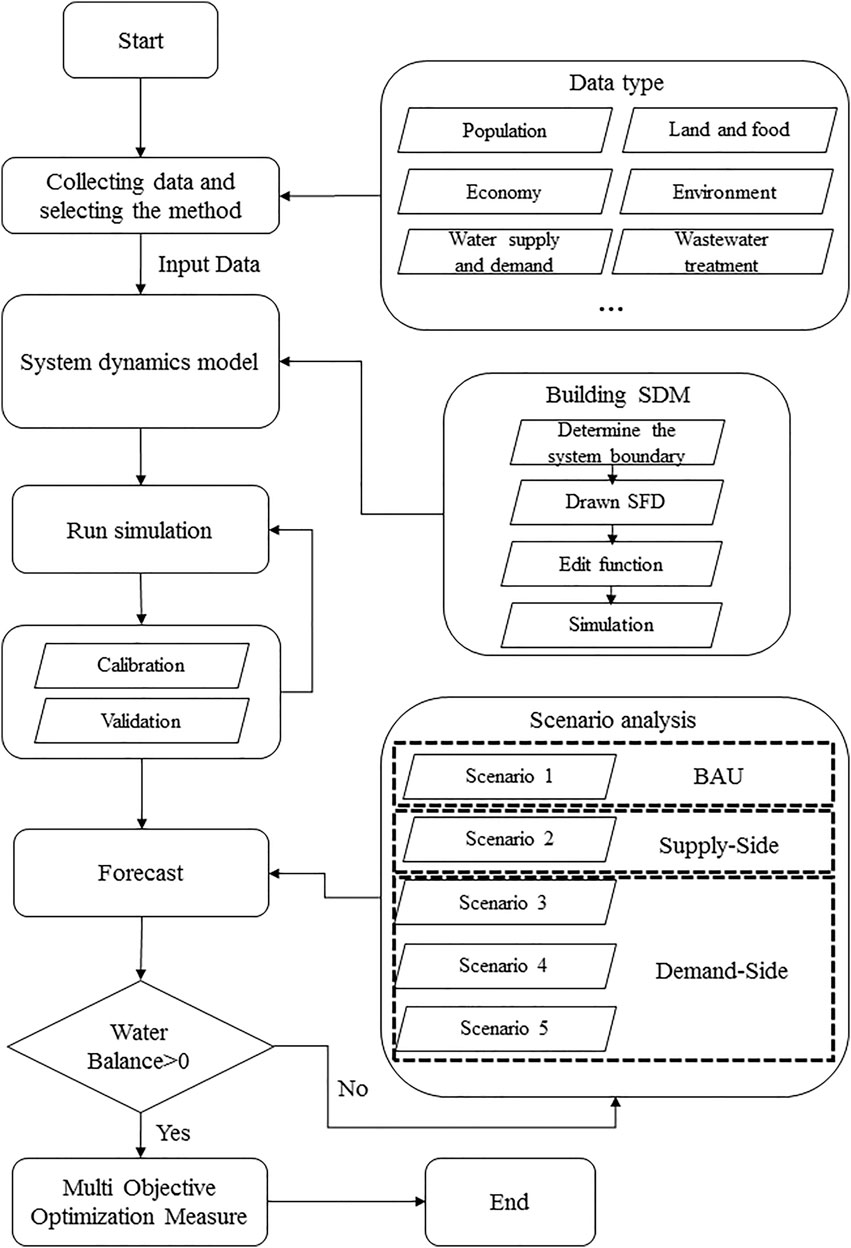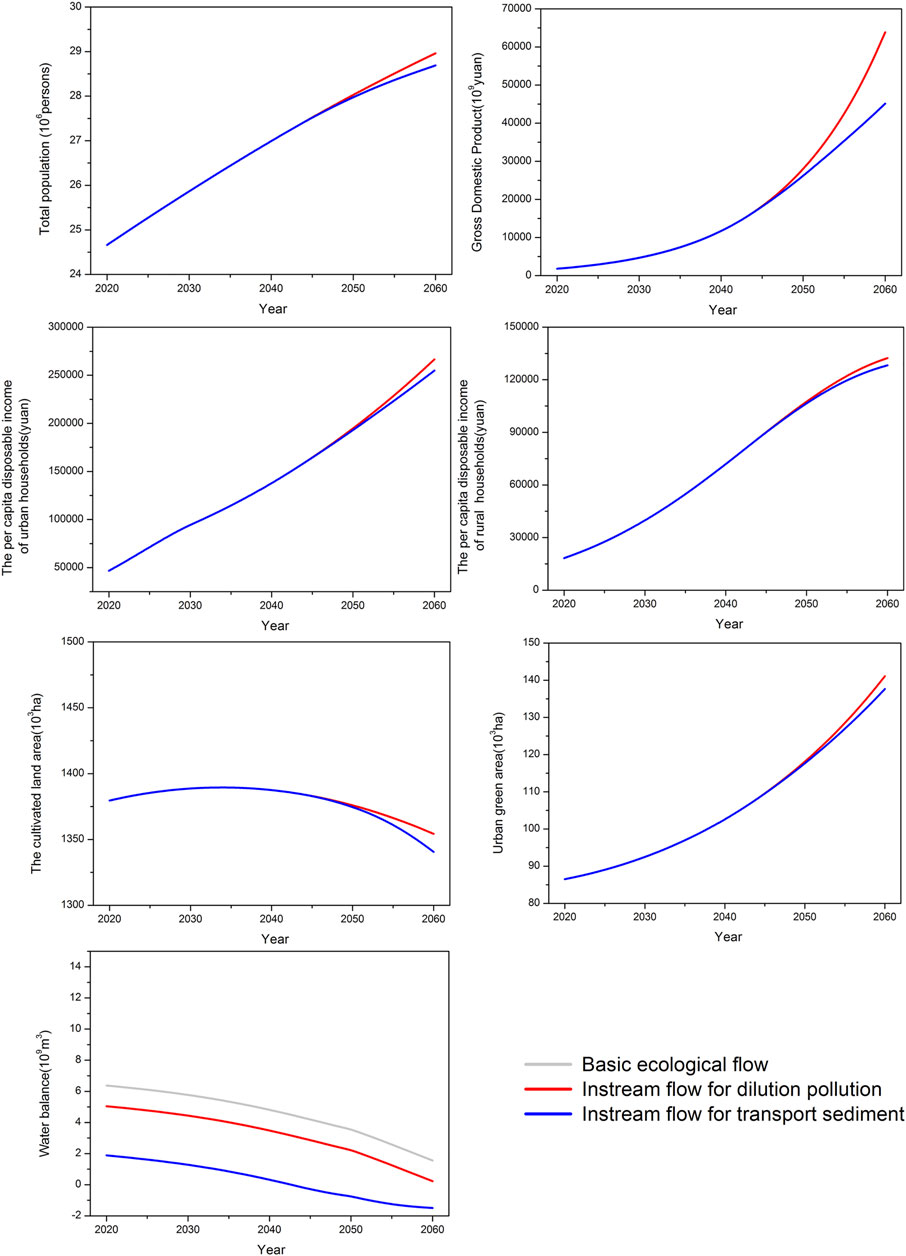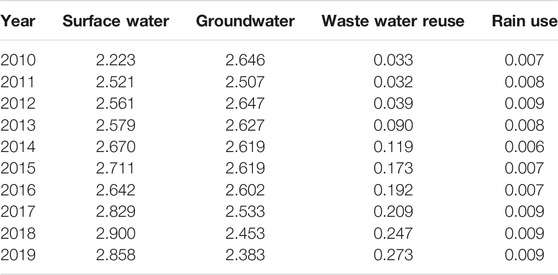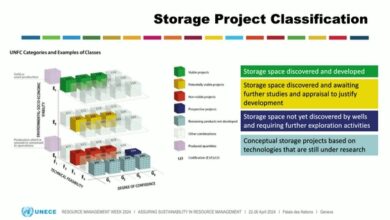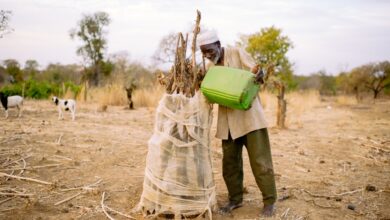Assessing the Impact of Optimization Measures on Sustainable Water Resource Management in the Guanzhong Area, China
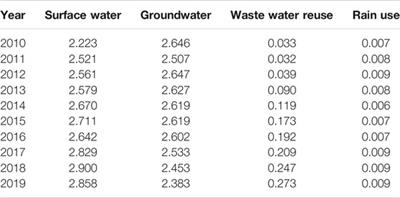
Introduction
Water resources are the core element of sustainable development. In the past few decades, people have increasingly recognized the importance of water resources and their services to socioeconomic development and eco-environmental protection (Bakker, 2012; Gleeson et al., 2012; UNEP, 2012). However, due to the uneven distribution of global water resources, rapid population growth and social water scarcity, watershed-scale water resource management is becoming increasingly challenging, especially in developing countries with water scarcity (Vörösmarty et al., 2000; Mirauda and Ostoich, 2011; Liu et al., 2013; Kotir et al., 2016). It is necessary to formulate adaptive water resource management policies to achieve social, economic and environmental sustainability (UNDP, 2015; Naghdi et al., 2021). Decision-makers are caught between the two options: strengthening the development of external water resources and optimizing the management of internal water resources, although both come with deficiencies. External resources may lead to water dependence and water conflict (Poff et al., 2003), while internal management is prone to blind policies and measures leading to an unsustainable occurrence. Therefore, researchers emphasize the use of new tools and technologies to improve water resource management, avoiding conflicts caused by water scarcities (Babel et al., 2005; Xu et al., 2013). Any behavior related to water resources may have an impact on related processes in the water system. The complex relationships and feedback among different systems present obstacles to understanding sustainable water resource management and evaluating water policies (Simonovic, 2009; Sterman, 2012; Mohamed et al., 2020). Unless the ecological environment and human uses of water are more clearly considered, the unsustainability of water will continue to worsen.
We conceptualize sustainable water resource management as a dynamic interaction between social economy and ecosystems in response to human driving factors. Deemed a suitable tool to study complex human-environmental systems, the system dynamics explains complex phenomena and processes by simulating system behavior and its changes over time (Sterman, 2000; Simonovic, 2009). Sustainable water resource management involves water resource planning and decision-making by using feedback views and models, integrating all aspects of the water system (Liu et al., 2015; Sahin et al., 2015; Behboudian et al., 2021). System dynamics uses the characteristics of feedback to find the root of the problem from the perspective of system structure, which is conducive to strengthening the understanding of the objective world and testing the effects of various policy measures (Simonovic, 2009; Sivapalan, 2015).
The system dynamics model (SDM) is a mature modeling tool that includes different advanced modeling platforms. This model is based on the developer’s concentrated thinking on the system and can be adjusted according to the level and experience of different users, thereby promoting the consensus of stakeholders. Moreover, the SD model can simulate a variety of scenarios to evaluate the impact of decisions and measures and identify effective adaptation strategies. Hence, the SDM provides an understanding of the long-term dynamic behavior of complex systems and the response of intervention measures, combining climate, resources, social, economic and environmental factors and decision-making measures in an integrated manner (Zare et al., 2019). At present, some system simulation models of different watersheds around the world have been developed based on SDM methods (Dawadi and Ahmad, 2013; Gohari et al., 2013; Sun et al., 2017; Bakhshianlamouki et al., 2020; Naderi et al., 2021). The diversity of their applications is helpful to research in the field of sustainable development.
The Chinese government proposed a major national strategy in 2019, the ecological protection and high-quality development of the Yellow River Basin. The Yellow River Basin is an important ecological barrier and economic zone in China and is of great significance to China’s social economic development and ecological security. As the largest tributary of the Yellow River, Weihe River Basin water resource management will directly affect the implementation of the national strategy. However, the limited water resources hinder the development of the socio economic and ecological environment in the basin. To tackle this issue, the Weihe River Basin management department is expanding the available water resources in the region through reservoir construction and water transfer projects. This management program of seeking external water sources is considered an effective solution to water scarcities. However, if the impact of related factors is not considered, providing more water will be counterproductive (Song et al., 2018). The comprehensive solution to the water scarcity problem is the goal of policy optimization, which is to control the behavior of the system through multiple strategic options and improve the reliability of water resources in the basin. Thus, a new evaluation framework is established based on the previous research of our project team (Song et al., 2018). The model was originally developed for water scarcity. This study will review and expand developed models and understanding to solve the challenges of sustainable water resource management related to the socio-economic and ecological environment.
Assessment of Water Management: A New Case Example
This paper improves the system dynamics model recently developed by the project team, and re-evaluates the socio-economic and ecological environmental dimensions of sustainable water resource management from a new perspective. Compared to the previous study, the structure of some subsystems has been optimized, the impact of ecosystem services on rebalancing between systems has been identified, and the importance and participation of stakeholders have been considered in the system.
The project team, decision-makers, and stakeholders emphasized that the decision-making on the sustainability of water resources must be strengthened under effective overall guidance. To optimize the result, the opinions of stakeholders affected by the watershed should be taken into account and applied to decision support at the system level (Zilio et al., 2019). In this sense, our research expects to help local communities develop their solutions and provide them to decision-makers.
Site Description
The Weihe River originates from Niaoshu Mountain in southwestern Weiyuan County, Dingxi City, Gansu Province, passes through the three provinces of Gansu, Ningxia and Shaanxi, and flows into the Yellow River in Tongguan County, Shaanxi Province. As the largest primary tributary in the Yellow River Basin, the Weihe River has a total length of 818 km and a drainage area of approximately 1.34 × 105 km2. The Guanzhong area, an area of approximately 55,000 km2, is an important political, economic and cultural core area of Shaanxi Province, with the total economic volume accounting for 70% of Shaanxi Province (Figure 1). The Weihe River is known as the mother river in the Guanzhong area, supporting production and domestic water demands (Dou et al., 2018).
The Guanzhong area contains a wide range of water supply projects and construction plans. The management department of the Weihe River has proposed building a rich regional water supply network based on a natural water system supplemented by artificial water transmission channels in recent years. Meanwhile, supporting reservoirs have been built or are under construction, such as the Dongzhuang Reservoir, Doumen Reservoir and Tingkou Reservoir. Managers hope to achieve the goal of water security in the Weihe River Basin by improving the water supply capacity and water utilization efficiency of the Guanzhong area. The time-consuming construction of water conservancy projects may present difficulty to the assessment.
Data Sources
Multiple data sources were involved in the model parameterization. There are seven types of data required by the model (including population, economy, household life, land and food, water supply and demand, wastewater recycling, and the ecological environment). These data have been provided by the project team and re-collection. Data sources include the statistical yearbook of Shaanxi Province (SXBS (Shaanxi Bureau of Statistics), SXITNBSC (Shaanxi Investigation Team of National Bureau of Statistics of China), 2002–2020), the Water Resources Bulletin, Shaanxi Water Conservancy Statistical Yearbook and some literature. Key parameters, values and data source information are provided in Table 1.
Methodology
System Dynamics Model
The development of SDM was considered to be a valuable thinking and learning process. A model based on the system framework can reveal the cause of the problem, provide predictive results, and choose a solution. Such a view is widely recognized in system dynamics and review literature (Zare et al., 2019). SDM is a method that can provide comprehensive results by outputting system results via focusing on the relationship between and within each system element through a comprehensive and dynamic perspective, which is important for specific aspects of the modeling process.
Model Improvement
For a detailed introduction of the sub-system, please refer to the previous research of the project team (Song et al., 2018). Here we focus on the improvement of the model, which is mainly divided into the following two aspects:
Ecological Environment Subsystem
We have broadened the selectivity of the ecological environment subsystem. In this paper, we extend the key role of water resources in the socio-economic and ecological environment. Ecosystem integrity is the principle in the pursuit of sustainable water resource management. The sustainability of water depends on the provision of ecosystem services. This interdependence indicates that water policy should prioritize ecosystems and their services. Sustainable water resource management emphasizes the gradual reduction of water vulnerability, so the corresponding policy formulation must be internalized by all stakeholders, instead of solely relying on the management department.
People are increasingly aware of the importance of protecting environmental flows (Scott et al., 2021). However, the demand for environmental flow is not linear. Decision-makers need to use environmental flow as a dynamic parameter for different purposes, rather than a fixed value. The redesigned subsystem can define appropriate environmental flows based on the opinions of policy stakeholders, such as designing environmental flows with different ecological functions or adding time functions to simulate cascading changes in time series. We used three different environmental flow configurations to simulate the different attitudes of stakeholders towards ecological water use in this study.
Land and Food Resource Subsystem
We have optimized the structure of the original model subsystem and to promote the link between land use and grain yield more accurately. Water resources are the basis of food security. Land and food systems depend on the provision of water resources system services. Water resources policies should consider the irrigation of crops in local communities to provide people with sufficient water to sustain food production. Therefore, we re-expanded this complex relationship between land and food and optimized the structure of the original model. We have added two new stock variables total sown area (TSA) and Sown Area of grain crops (SAGC). TSA and SAGC refer to the total sown area of various crops and grain in crops throughout the year, respectively. The improved subsystem will simulate the process of system feedback through four stock variables. The specific operation methods include: 1) Establish Multiple-crop index (MCI) parameters between total cultivated field area (TCA) and total sown area (TSA), MCI represents the ratio of TSA to TCA; 2) Establish the ratio of total sown area and sown area of grain crops (GCSI) parameters between TSA and sown area of grain crops (SAGC), GCSI represents the ratio of SAGC to TSA; 3) Establish per unit area of grain production (PUA) parameters between Grain yield (GY) and SAGC, and PUA parameters represent the ratio of SAGC to GY. Generally speaking, unless there are significant changes in technology and policies, these control parameters will remain within a fixed range. The improved model structure can examine the prediction results of grain yield through the above land use control parameters, thereby improving the assessment of food security in the subsystem.
Model Setting
A framework of the flow chart of this research is shown in Figure 2. The boundaries of the improved model were limited to the Guanzhong area. The model consists of seven interrelated subsystems, including 123 variables. The new stock-flow diagram (SFD) of the improved model indicates the direction and change of feedback between different systems (Figure 3). System simulation was achieved using the professional system dynamics software package Vensim PLE (www.vensim.com). The model simulation time is from 2001 to 2060, and the time step is 1 year. The input data related to the model were collected in 2001–2019 and used for the model calibration and verification.
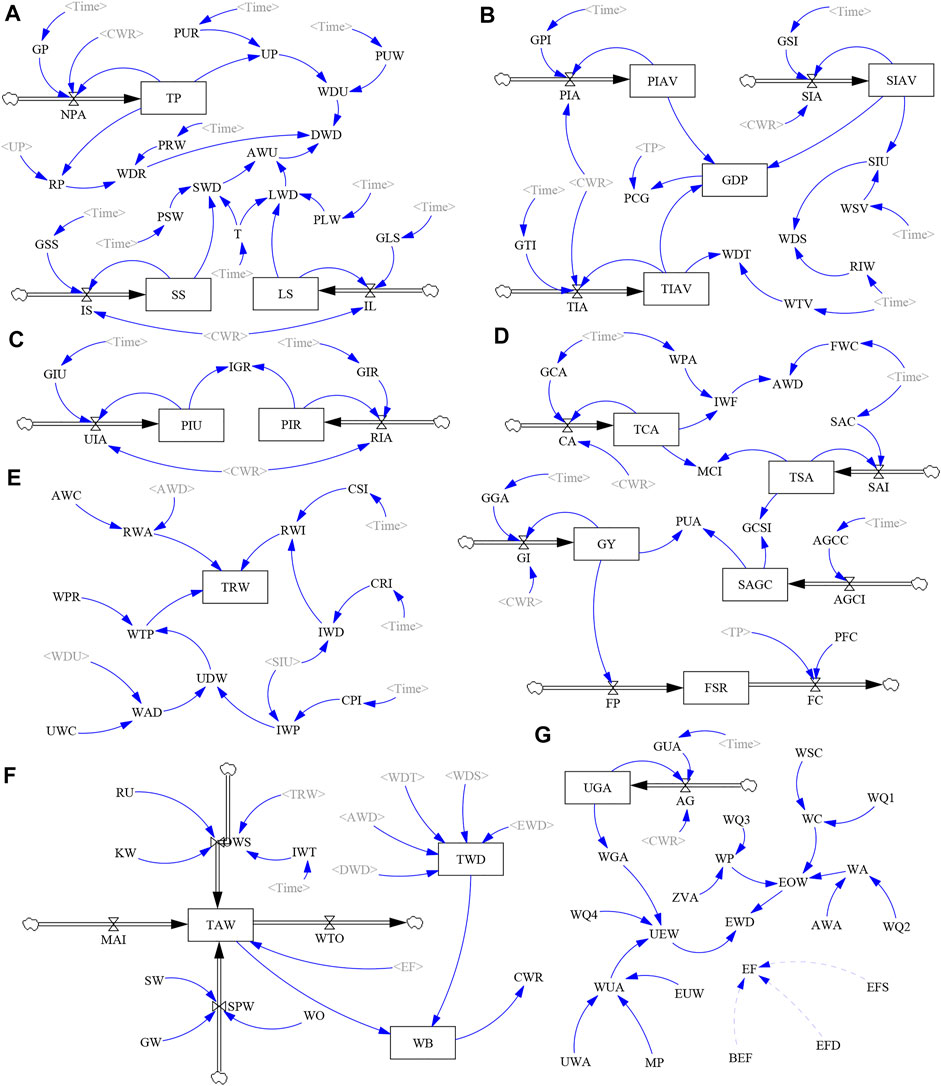
FIGURE 3. A system dynamic stock-flow diagram of the improve system, including subsystems of (A) population, (B) economy, (C) the livelihoods of people, (D) land and food resource, (E) recycled water, (F) water supply and demand, (G) ecological environment.
Model Testing
Compared with the black box model driven by pure data, SDM pays more attention to the rationality of system structure (Sterman, 2000). This point of view runs through the entire process of developer modeling, such as determining system goals, drawing causal loop diagrams and constructing stock-flow diagrams. To this end, a series of tests were performed, including testing of the system structure, overall consistency and model error. To achieve the relevant goals of system research, a test of the system structure and overall consistency was carried out to determine whether the model fit the actual system. The model error was used to study the accuracy of the model output. The data simulated by the model were compared with the historical data to ensure consistency.
In this study, the test tools in the Vensim PLE software package, the coefficient of determination (R2), discrepancy coefficient (U0), the absolute relative error (ARE) and the mean absolute relative error (MARE) test combinations were used to verify the model. The system structure test will be completed by the software package tool. The coefficient of determination (Eq. 1), the discrepancy coefficient (Eq. 2), the absolute relative error (Eq. 3) and the mean absolute relative error (Eq. 4) were employed to test the performance of the model. Furthermore, the views of some experts and stakeholders were collected to verify of SD model.
where Ysim and Yobs are the simulated and observed data point for the tested parameter, respectively; Cov (Ysim, Yobs) is the covariance of the simulated and observed data; and σYsim and σYobs are the standard deviations of simulated and observed sets of values.
Scenario Analysis
Scenario analysis can be used to assess future uncertainties and help develop water resource management strategies (Carter et al., 2007). Combined with the existing planning research of government departments and expert opinions, the management policies are identified as five scenarios. These five scenarios reflect the impact of different measures and stakeholders on the system. First, we propose a business as usual (BAU) scenario. The other four scenarios control system behavior through the supply-side, demand-side management and stakeholder attitudes. The description and parameter settings of each scenario are displayed in Tables 2, 3. The parameter settings of the water resource utilization efficiency are summarized in Table 4.
Results
Model Calibration and Validation
The structure and unity of the system were confirmed before running the model. To conduct model calibration and validation, we divide the simulation results and the historical data series during the period of 2001–2019 into two parts. One part from 2001–2014 is used for model calibration, and the rest was used for model validation. These tests will contribute to improving the reliability and confidence of the SD model. Figure 4 shows the test results of the relevant variables. Among the tested system parameters, the coefficients of determination (R2) values of TP and UGA are relatively low, at 0.89 and 0.87, respectively. The urban expansion and new talent introduction policies in the Guanzhong area may be the cause of this deviation. The maximum and the minimum values of the model difference discrepancy coefficient (U0) are 0.0009 and 0.002, respectively. Meanwhile, the mean absolute relative error (MARE) of the model during calibration and verification are 0.016 and 0.033, respectively. The results of the model showed that the simulated values were in good agreement with the observed values.
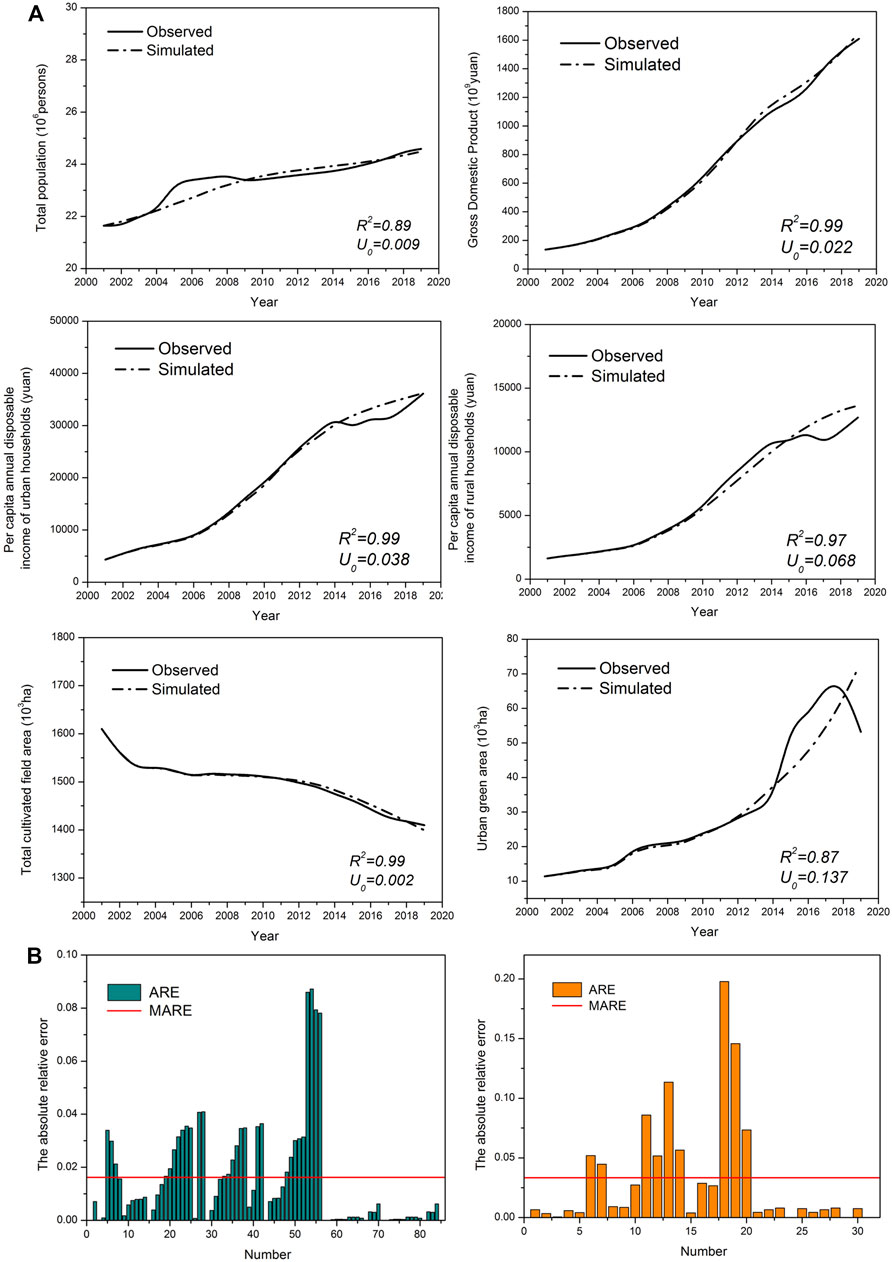
FIGURE 4. Results of calibration and validation, (A) the coefficient of determination (R2) and discrepancy coefficient (U0) between simulated results and observed data, (B) calibration and validation results using Absolute Relative Error (ARE) and Mean ARE (MARE).
Simulation Results
Business As Usual Scenario
In the BAU scenario, the system show similar development results for the three different environmental flow configurations. With the continuous growth of water demand caused by social and economic development, the available water resources in the Guanzhong area will be depleted. Figure 5 shows the simulation results of the water resource balance, indicating that the water resources of the Weihe River Basin under the three configurations are unsustainable. The water resources that meet the allocation of sediment transport will face water scarcity in 2043. It is predicted that the water scarcity in the Guanzhong area will reach 1.4 × 109 m3 in 2060. The simulation results in Table 5 show that the total population decreased by 0.2731 × 106 people and is affected by restrictions on the growth of water resources. GDP decreased from 63,883.2 × 109 yuan to 45,108.5 × 109 yuan, and PCG also showed a downward trend. With the reduction in the disposable income of households, the gap index has slightly expanded. In terms of land and grain, the reduction in cultivated land accelerated from 1,354.25 × 103 ha reduced to 1,340.56 × 103 ha. The grain output per unit area remained relatively stable, while the grain output decreased relatively. The current food self-sufficiency rate in the Guanzhong area fluctuates between 0.8 and 0.9. The simulation results showed that the future food self-sufficiency rate in the Guanzhong area fluctuates between 0.7 and 0.8, further increasing the food security risk. Table 5 shows the simulation results of some stock variables in the BAU scenario.
Scenario Analyses
Figures 6, 7 show the change trend of the selected variables of the four scenarios due to different supply-side and demand-side management policies and measures in the simulation range (2020–2060).
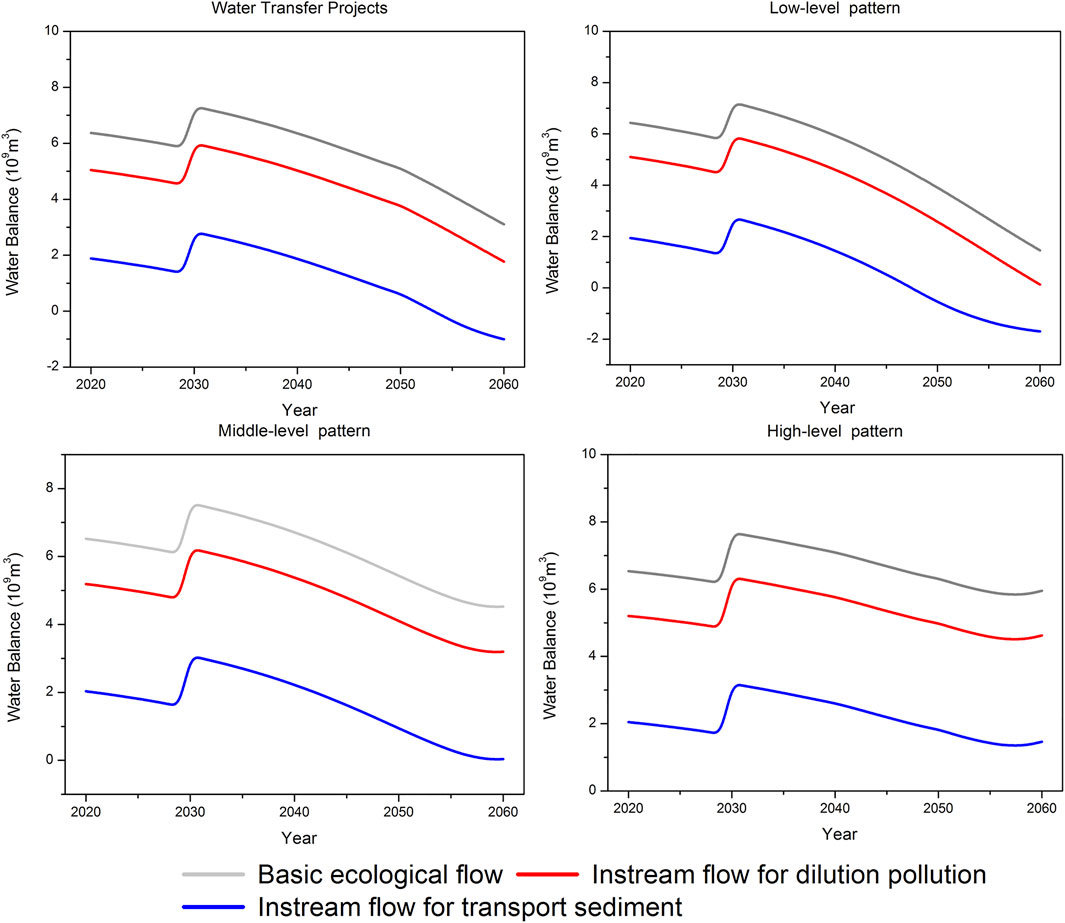
FIGURE 6. The simulation results of water balance in four scenarios (scenario 2, scenario 3, scenario 4, and scenario 5) under three EF allocations (BEF, EFD, EFS).

FIGURE 7. The behavior of water use variables under three EF allocations, (A) base ecological flow, (B) instream flow for dilution pollution, (C) instream flow for transport sediment.
Scenario 2 produced similar results as Scenario 1. Under the condition that the system meets the environmental requirements of the sediment transportation configuration, water scarcity is expected in 2054 in the later stage of simulation. Compared with Scenario 1, the water transfer project alleviated water scarcity and reduced the risk to water resources in the Guanzhong area. The increase of 1 × 109 m3 of water resources in the second phase of the Han-to-Weihe River Diversion Project delayed the occurrence of water scarcity by 12 years. Although the improvement of available water resources impacted the balance of water resources, it did not benefit the water savings, because the water demand will not be reduced. The pressure on water resources brought about by social and economic development cannot be eliminated. However, the simulation results show that the supply-side solution provides promising results for solving water scarcity.
The simulation results of scenario 3 show that sacrificing the speed of socio-economic development cannot have a positive impact on watershed water resources. Water-saving measures are a key policy lever for reducing water consumption in river basins. Although reducing the speed of social and economic development can lower the demand for water resources in the early stage, the decline of technology and policy will further aggravate the shortage of water resources. The simulation results in Figure 6 show that the unsustainability of water resources increases under the low development mode. The system predicts water scarcity in 2048, reaching 1.69 × 109 m3 in 2060, with the upward trend of industrial water use will becoming steep. The implementation of this policy of demand-side management requires a re-examination of the adverse effects of development and technological regression on the future management of the Guanzhong region.
The system can meet the water demand of each department during the whole simulation period without water scarcity in scenario 4. Although the speed of social-economic development increased, the sustainability of water resources was significantly enhanced due to the improvement of water-saving technologies. Agricultural water use began to show a slight downward trend. Industrial water use is controlled. Tertiary industry water use tended to be flat in the later period. Compared with scenario 3, this scenario seems to provide a satisfactory solution to achieve sustainable water resource management.
The results of Scenario 5 emphasize the key role of water-saving technologies in the sustainable use of water resources and social and economic development. Compared with the previous scenario, the growth rate of the socio-economic sector parameter and water-saving plan in this scenario improved. However, in addition to the steady growth of agricultural water, domestic water, and ecological water, the demand for industrial water and tertiary industry water exhibited a downward trend. Regarding the water resource balance, this scenario yielded increased water resource reliability and reduced vulnerability, indicating that improving demand-side management (improving water resource utilization efficiency) as a water policy can fully meet the rapid social and economic development in the future.
Sustainability Evaluation
The results of the model analysis show that the attitudes of stakeholders will different water distribution and management. The three types of environmental flows represent different stakeholders’ perceptions of the importance of ecological water use in water distribution. This will directly affect water resource planning and the formulation of management policies. At this point, achieving sustainable management of water resources requires continuous trade-offs between uses and users. The vulnerability of water resources can be reduced under the dual management of the supply-demand side, and the sustainable development of the social economy and the ecological environment can be realized in the Guanzhong area.
In addition, this scenario-based analysis show that the management department can provide sufficient available water resources through the water transfer project on the supply side. However, this development model is unsustainable in the long run due to the problem of water limiting growth. Relying on demand-side management and other measures to provide reliable and sufficient water resources to meet development needs will be a new challenge for watershed water resource management. This is the fundamental problem of the governance of water-deficient areas, and the area’s development exceeds the limit of available water resources (Bahaddin et al., 2018).
This study has similar results with previous studies in some respects. For example, the two-research emphasized that improving water use efficiency is a driving factor of sustainable water management. However, the focus of this study is to explore the impact of supply-side and demand-side management on community water management and policy-making, especially in water scarcity areas. Simultaneously, we have emphasizes that stakeholder participation is of great significance to sustainable water resources management. The following discussion will focus on these contents.
Discussion
Restricted Development
Although the results of the model show that the development of the supply side and the improvement of demand-side management can achieve the sustainability of water resources in the Guanzhong area. However, the implementation of water policies may be limited by human and climate driving factors and cause water scarcity, such as extreme arid climates and unequal water competition. The new water management policy in the Guanzhong area is still in the process of planning and construction, which undoubtedly enhances the uncertainty of sustainable water resource management in the future.
The scenario analysis showed that water scarcity limits not only social and economic growth but also affects other aspects of the system. First, Water scarcities will widen the income gap between urban and rural residents, affecting the well-being of residents. A decline in income will impact the level of consumption, which affects the expenditure on water resources. Income and expenditure determine the attitude of stakeholders: when income does not exceed expenditure expectations, no one has shown interest in improving water management; but due to the negative impact of water pressure, the water-saving awareness of stakeholders will be improved. Some studies have shown that water price increases will directly affect water consumption (Li et al., 2018). Managers can control water prices to promote water savings and reduce wastewater discharge. Second, the improved model shows that there are food security risks in the Guanzhong area. This is a different answer from previous research. It may be necessary to purchase sufficient food from outside regions if no measures are taken in the future. Water scarcity may exacerbate the imbalance between food supply and demand. The changes in grain production impact land use and could even affect the ecosystem (Yang F. et al., 2021). Therefore, ensuring adequate water resources is the key to the future social and economic development of the Guanzhong area.
Policy Implications
In Scenario 2, the water transfer project increased the available water resources in the Guanzhong area. The construction of water conservancy projects is expensive and time-consuming, and their impact on the ecological environment and biodiversity is difficult to evaluate (Abell et al., 2008; Jiang et al., 2020). However, such projects as an effective management tool are currently being implemented in the Guanzhong area, positively impacting local development. Although relying on external water resources enhances the water resources carrying capacity of the Guanzhong area, the water transfer projects may be forced to stop in case of a water crisis in the water transfer basin, thus affecting the downstream water-receiving area. Management strategies tend to be biased towards supply-side development in the case of water scarcity, but people are increasingly aware of the potential of demand-side management and other solutions. The system simulation results show that focusing on demand-side management is more effective than water supply-side management.
All scenario analyses show that the sustainable utilization of water resources in the Guanzhong area must rely on improving water resource utilization efficiency, which is an important policy decision point. Scenario 5 is the best solution for demand-side management, including increasing the agricultural water consumption coefficient and wastewater plant treatment rate and reducing the water use per unit of industry AV, water use per cultivated area and per capita water use per day. As mentioned in other studies, the effectiveness of water-saving technologies as a solution to problems is controversial (Bian et al., 2014; Yang S. et al., 2021). The implementation of this measure often requires sufficient technical, financial and policy support, especially the increase in public awareness and participation. If the reduction of water demand through development speed was carried out without considering water efficiency, such a measure may harm social and economic development, as shown in scenario 3. Thus, the best policy for sustainable water resource management is to improve demand-side management to reduce water consumption in various departments.
Environmental Water Indication
People are increasingly aware of the importance of environmental flows in watershed management (Wei et al., 2020). If we want to maintain the ecological functions of the river, it is necessary to ensure sufficient water for the environment. However, our experience shows that water use is not suitable for all purposes. Satisfying ecosystem functions is likely to affect drinking water or other human uses. Sometimes, decision-makers will introduce demand standards into supply-side-oriented management, thereby formulating a failed water policy.
Sustainable water management policies mean that decision-makers need to weigh the balance between water production, recreation, landscape, and biological protection. Decision-makers should consider future policy changes and stability to reduce conflicts of interest in water distribution. The improved model structure no longer sets the environmental flow as a fixed maximum value. The design should consider the different needs of stakeholders and provide more results through “selection” to improve the management of water resources. We selected three different configurations of environmental flow in this study. These represent the attitudes of different stakeholders, respectively. The results show that, if no measures were taken, the water resources in the Guanzhong area would not meet the ecological needs of sediment transportation in the future. However, some studies suggest that with the improvement of soil and water conservation and the ecological environment, the river sediment content of the Yellow River Basin has seen a yearly decrease (Sun et al., 2020; Zhao et al., 2021). Ecological water will be released into social and economic development in the future, which may require decision-makers to weigh the distribution of water in the system and the potential risks.
Other Measures
The managers have developed several other solutions to supplement the sustainable water resources management strategy in the Guanzhong area. These include the diversification of water resources, the change of the model that completely relies on the surface water and groundwater in the region, and the water management department actively expanding the use of recycled water and rainwater to meet water demand. An irrigation network will be constructed to connect the local water conservancy facilities (reservoirs and dams). Promote the gathering of industrial parks for companies by recycled water use. Finally, innovative building regulations require land developers for new projects to comply with green building standards to obtain development permits.
At present, the Guanzhong area is improving the utilization rate of recycled water and rainwater through industrial upgrading and sponge city construction. Meanwhile, the river ecosystem protection plan is incorporated into the water policy management to ensure ecological safety. However, the management strategies announced by the water department seem to be slightly overlapping and hollow and it is difficult for some stakeholders to find specific approaches. Table 6 shows the supply of water resources in the Guanzhong area in the past 10 years. The Guanzhong area still relies on traditional water resources, and there is still a lot of room for the development of other water sources. Moreover, the water body is over-exploited or polluted and may threaten stakeholders in remote supply. It is difficult to find inter-regional water rights trading and compensation mechanisms in public information.
A variety of policies and measures may promote the solution of the water problem, including adjustment of tax structure, rainwater collection, and greywater reuse by urban households, policy incentives (incentives or subsidies) to reduce water demand, and encourage stakeholders to participate in planning.
Uncertainties of Climate Change
A critical uncertainty factor in our research is that the supply and demand of water resources caused by climate change are not considered. Studies have evaluated the impact of climate change and human activities on hydrological processes and water resources activities in different regions (Ahn and Merwade, 2014; Ran and Tao, 2017; Wang et al., 2020). Most of these studies focus on changes in water availability (Grouillet et al., 2015; Omer et al., 2020). Climate change, including extreme events such as droughts and floods, may affect ecosystem services and water resources utilization throughout the basin (Brendel et al., 2017). Therefore, close connections exist among climatic conditions, water users, and distribution methods. However, the impact of human activities on water resources has exceeded climate change, especially when people are aware of adopting various measures to deal with the adverse effects of climate conditions. For instance, the supply-side plan is based on the construction of water conservancy projects to integrate flood and water supply management. Decision-makers need to consider effective management policies to meet the challenges of future climate.
Comparative Assessment
The previous research of the project team was based on the perspective of decision-makers, integrating all aspects of the water system to solve the problem of water shortage. In this study, we integrate model developers, stakeholders, and decision-makers into the same perspective, and employ improved model structures to simulate the impact of supply-side and demand-side management on water resources management strategies. The case study in the Guanzhong area summarizes the three principles of sustainable water resources management. These have been verified in our research and lead to our conclusions.
First of all, sustainable water resources management depends on the carrying capacity of water resources, the level of regional development and the common understanding of stakeholders. The case of the Guanzhong region shows that economically developed regions can determine ecological environmental protection and regulate demand through enhanced supply-side and demand-side dual management. In other words, Water policy can avoid unsustainable water management by combining supply-demand side measures. However, supply-side development may not be affordable in underdeveloped and disadvantaged regions. Decision-makers must weigh fairness between regions and systems. How stakeholders view and reach a common understanding is crucial to determining the results of water policies. Therefore, we recognize that demand-side management is more important than supply-side development in water-scarce areas. Reducing water demand can replace new water resources development plans and avoid falling into supply-oriented management. This is a point neglected in previous studies.
Second, improving ecosystem services is the basic goal of the sustainable development of water resources, which is closely related to the socio-economic system. Stakeholders may cause differences in demand management results for different purposes. The improved model structure shows that the ecological environment and social economy may be rebalanced at the expense of part of the ecological function. Specifically, high-quality water, availability, and fair access are the core values of sustainable water resources management. However, sustainable water resources management should be phased. The dynamic balance between systems requires water policy to pay more attention to fairness, stability and reduce conflicts of interest.
Third, no water policy can completely avoid the unsustainability of water resources due to extreme weather disasters and poor governance policies. Decision-makers should consider the stakeholders’ opinions in the decision-making process, which may reduce the human influence. The participation of stakeholders in water resources management has been reflected in the formulation of national-level strategies. However, this approach is still difficult to achieve in small and medium-sized river basins. This is mainly related to the division of administrative boundaries, the complexity of the governance structure, and the difficulty for decision-makers to refer to the opinions of users in the design process. Stakeholder leadership has emerged in water management at local and regional levels and this could translate into policy impact in the future (Scott et al., 2021). In addition, the open platform owned by SDM provides the possibility for stakeholder participation. Common values and more new ideas are considered, planned, and executed will help improve the efficiency of sustainable management strategies. This was verified in this study.
Conclusion
Water resources management should consider the participation of stakeholders and integrate all major components and problems into an overall system for research with decision-makers Otherwise, some policies and measures formulated cannot solve the current problems and even worsen after spending limited resources and time. Based on new perspectives and improved models, we compare and analyze the impact on sustainable water resource management through supply-side and demand-side management and other policy measures. The research aims to establish a new framework to evaluate the best policies and measures for sustainable development, not just research on water scarcity. This paper expands the three decision-making principles that we believe are related to sustainable development: 1) Follow a systematic and comprehensive approach to ensure sustainable development. Decision-makers need to weigh the differences between systems and regions to promote consensus among stakeholders; 2) Sustainable water resources management is phased, providing scientific water policies to achieve fairness, stability and reducing conflicts of interest; and 3) The uncertainty of future changes should be considered, the participation of stakeholders should be encouraged and promoted the efficiency of sustainable water management strategies. Beyond the principles set out above, consider the impact of the following policies on system behavior in the long run, which will lead to sustainable water management:
• Water transfer projects reduce the vulnerability of water resources, but water transfer measures between river basins are unsustainable in the long run.
• Demand-side management (improving water resource utilization efficiency) and other methods (irrigation systems, wastewater treatment, rainwater and reclaimed water reuse, etc.) are more important than supply-side development (as new water resources), especially in economically disadvantaged areas. Reducing water use in various sectors can replace new water resources development plans.
• The improvement of the eco-environment will help release water resource and further promote social economic development.
• The participation of stakeholders is essential to determine the results of water policies, which will help decision-makers weigh water allocation and policy risks and minimize the impact of human factors.
To improve the model in future research work, the recommendations are as follows. First, we hope that more stakeholders will participate, which can promote the optimization of the system structure and improve the performance of the model. Second, the analysis of scenarios may not be comprehensive and factors such as extreme arid climate have not been considered. More scenarios can help improve the quality of water policy management.
Data Availability Statement
The original contributions presented in the study are included in the article/Supplementary Material, further inquiries can be directed to the corresponding author.
Author Contributions
BT contributed to the conceptualization, ideas, methodology, model improvement, validation, original paper draft and visualization. RM, HS, FK, and DC contributed to results discussion and edit the paper. JS supervised the project, helped results analysis, contributed to financial support. XG contributed to study area definition and data re-collection. All authors contributed to manuscript revision, read, and approved the submitted version.
Funding
This study was supported by the Special Funds of the National Natural Science Foundation of China (Grant No. 42041004), Program for Key Science and Technology Innovation Team in Shaanxi Province (Grant No. 2014KCT-27) and the Shaanxi Province Water Conservancy Science and Technology Project (No. 2021slkj-13).
Conflict of Interest
The authors declare that the research was conducted in the absence of any commercial or financial relationships that could be construed as a potential conflict of interest.
Publisher’s Note
All claims expressed in this article are solely those of the authors and do not necessarily represent those of their affiliated organizations, or those of the publisher, the editors and the reviewers. Any product that may be evaluated in this article, or claim that may be made by its manufacturer, is not guaranteed or endorsed by the publisher.
Supplementary Material
The Supplementary Material for this article can be found online at: https://www.frontiersin.org/articles/10.3389/fenvs.2021.805513/full#supplementary-material
References
Abell, R., Thieme, M. L., Revenga, C., Bryer, M., Kottelat, M., Bogutskaya, N., et al. (2008). Freshwater Ecoregions of the World: A New Map of Biogeographic Units for Freshwater Biodiversity Conservation. BioScience 58 (5), 403–414. doi:10.1641/b580507
Ahn, K.-H., and Merwade, V. (2014). Quantifying the Relative Impact of Climate and Human Activities on Streamflow. J. Hydrol. 515, 257–266. doi:10.1016/j.jhydrol.2014.04.062
Babel, M. S., Gupta, A. D., and Nayak, D. K. (2005). A Model for Optimal Allocation of Water to Competing Demands. Water Resour. Manage. 19 (6), 693–712. doi:10.1007/s11269-005-3282-4
Bahaddin, B., Mirchi, A., Watkins, D., Ahmad, S., Eliot, R., and Madani, K. (2018). “System Archetypes in Water Resource Management,” in World Environmental and Water Resources Congress 2018: Watershed Management, Irrigation and Drainage, and Water Resources Planning and Management (Reston, VA: American Society of Civil Engineers Reston), 130–140. doi:10.1061/9780784481400.012
Bakhshianlamouki, E., Masia, S., Karimi, P., van der Zaag, P., and Sušnik, J. (2020). A System Dynamics Model to Quantify the Impacts of Restoration Measures on the Water-Energy-Food Nexus in the Urmia lake Basin, Iran. Sci. Total Environ. 708, 134874. doi:10.1016/j.scitotenv.2019.134874
Behboudian, M., Kerachian, R., Motlaghzadeh, K., and Ashrafi, S. (2021). Evaluating Water Resources Management Scenarios Considering the Hierarchical Structure of Decision-Makers and Ecosystem Services-Based Criteria. Sci. Total Environ. 751, 141759. doi:10.1016/j.scitotenv.2020.141759
Bian, Y., Yan, S., and Xu, H. (2014). Efficiency Evaluation for Regional Urban Water Use and Wastewater Decontamination Systems in China: A DEA Approach. Resour. Conservation Recycling 83, 15–23. doi:10.1016/j.resconrec.2013.11.010
Carter, T. R., Jones, R. N., Lu, X., Bhadwal, S., Conde, C., Mearns, L. O., et al. (2007). “New Assessment Methods and the Characterisation of Future Conditions,” in Climate Change 2007: Impacts, Adaptation and Vulnerability. Contribution of Working Group II to the Fourth Assessment Report of the Intergovernmental Panel on Climate Change. Editors M. L. Parry, O. F. Canziani, J. P. Palutikof, P. J. van der Linden, and C. E. Hanson (Cambridge, United Kingdom: Cambridge University Press), 133–171.
Cui, Z. L. (2009). Study on the Water Resources Allocation for the Weihe River in Shaanxi Province. Yangling, China: Northwest A&F University. (in Chinese).
Dawadi, S., and Ahmad, S. (2013). Evaluating the Impact of Demand-Side Management on Water Resources under Changing Climatic Conditions and Increasing Population. J. Environ. Manag. 114, 261–275. doi:10.1016/j.jenvman.2012.10.015
Dou, X., Song, J., Wang, L., Tang, B., Xu, S., Kong, F., et al. (2018). Flood Risk Assessment and Mapping Based on a Modified Multi-Parameter Flood hazard index Model in the Guanzhong Urban Area, China. Stoch Environ. Res. Risk Assess. 32 (4), 1131–1146. doi:10.1007/s00477-017-1429-5
Gleeson, T., Wada, Y., Bierkens, M. F. P., and van Beek, L. P. H. (2012). Water Balance of Global Aquifers Revealed by Groundwater Footprint. Nature 488 (7410), 197–200. doi:10.1038/nature11295
Gohari, A., Eslamian, S., Mirchi, A., Abedi-Koupaei, J., Massah Bavani, A., and Madani, K. (2013). Water Transfer as a Solution to Water Shortage: A Fix that Can Backfire. J. Hydrol. 491, 23–39. doi:10.1016/j.jhydrol.2013.03.021
Grouillet, B., Fabre, J., Ruelland, D., and Dezetter, A. (2015). Historical Reconstruction and 2050 Projections of Water Demand under Anthropogenic and Climate Changes in Two Contrasted Mediterranean Catchments. J. Hydrol. 522, 684–696. doi:10.1016/j.jhydrol.2015.01.029
Huang, X. G. (2007). Shaanxi Province Water Resources Natural Gift Characteristic and its Development Make Use of Strategic Research. Xi’an, China: Chang’an University. (in Chinese).
Jiang, H., Simonovic, S. P., Yu, Z., and Wang, W. (2020). A System Dynamics Simulation Approach for Environmentally Friendly Operation of a Reservoir System. J. Hydrol. 587, 124971. doi:10.1016/j.jhydrol.2020.124971
Kotir, J. H., Smith, C., Brown, G., Marshall, N., and Johnstone, R. (2016). A System Dynamics Simulation Model for Sustainable Water Resources Management and Agricultural Development in the Volta River Basin, Ghana. Sci. Total Environ. 573, 444–457. doi:10.1016/j.scitotenv.2016.08.081
Li, Z., Li, C., Wang, X., Peng, C., Cai, Y., and Huang, W. (2018). A Hybrid System Dynamics and Optimization Approach for Supporting Sustainable Water Resources Planning in Zhengzhou City, China. J. Hydrol. 556, 50–60. doi:10.1016/j.jhydrol.2017.11.007
Liu, H., Benoit, G., Liu, T., Liu, Y., and Guo, H. (2015). An Integrated System Dynamics Model Developed for Managing lake Water Quality at the Watershed Scale. J. Environ. Manag. 155, 11–23. doi:10.1016/j.jenvman.2015.02.046
Liu, S., Crossman, N. D., Nolan, M., and Ghirmay, H. (2013). Bringing Ecosystem Services into Integrated Water Resources Management. J. Environ. Manag. 129, 92–102. doi:10.1016/j.jenvman.2013.06.047
Mirauda, D., and Ostoich, M. (2011). Surface Water Vulnerability Assessment Applying the Integrity Model as a Decision Support System for Quality Improvement. Environ. Impact Assess. Rev. 31 (3), 161–171. doi:10.1016/j.eiar.2010.07.003
Mohamed, M. M., El-Shorbagy, W., Kizhisseri, M. I., Chowdhury, R., and McDonald, A. (2020). Evaluation of Policy Scenarios for Water Resources Planning and Management in an Arid Region. J. Hydrol. Reg. Stud. 32, 100758. doi:10.1016/j.ejrh.2020.100758
Naderi, M. M., Mirchi, A., Bavani, A. R. M., Goharian, E., and Madani, K. (2021). System Dynamics Simulation of Regional Water Supply and Demand Using a Food-Energy-Water Nexus Approach: Application to Qazvin Plain, Iran. J. Environ. Manag. 280, 111843. doi:10.1016/j.jenvman.2020.111843
Naghdi, S., Bozorg-Haddad, O., Khorsandi, M., and Chu, X. (2021). Multi-objective Optimization for Allocation of Surface Water and Groundwater Resources. Sci. Total Environ. 776, 146026. doi:10.1016/j.scitotenv.2021.146026
Omer, A., Elagib, N. A., Zhuguo, M., Saleem, F., and Mohammed, A. (2020). Water Scarcity in the Yellow River Basin under Future Climate Change and Human Activities. Sci. Total Environ. 749, 141446. doi:10.1016/j.scitotenv.2020.141446
Poff, N. L., Allan, J. D., Palmer, M. A., Hart, D. D., Richter, B. D., Arthington, A. H., et al. (2003). River Flows and Water Wars: Emerging Science for Environmental Decision Making. Front. Ecol. Environ. 1 (6), 298–306. doi:10.1890/1540-9295(2003)001[0298:rfawwe]2.0.co;2
Ran, Z., and Tao, F. (2017). Contributions of Climate Change and Human Activities to Runoff Change in Seven Typical Catchments across China. Sci. Total Environ. 605-606 (dec.15), 219–229. doi:10.1016/j.scitotenv.2017.06.210
Sahin, O., Stewart, R. A., and Porter, M. G. (2015). Water Security through Scarcity Pricing and Reverse Osmosis: a System Dynamics Approach. J. Clean. Prod. 88, 160–171. doi:10.1016/j.jclepro.2014.05.009
Scott, C. A., Zilio, M. I., Harmon, T., Zuniga-Teran, A., Díaz-Caravantes, R., Hoyos, N., et al. (2021). Do ecosystem Insecurity and Social Vulnerability lead to Failure of Water Security. Environ. Develop. 38, 100606. doi:10.1016/j.envdev.2020.100606
Simonovic, S. P. (2009). Managing Water Resources: Methods and Tools for a Systems Approach. London;Paris: UNESCO.
Sivapalan, M. (2015). Debates-Perspectives on Socio-Hydrology: Changing Water Systems and the “tyranny of Small Problems”-Socio-Hydrology. Water Resour. Res. 51 (6), 4795–4805. doi:10.1002/2015WR017080
Soledad Brendel, A., Yael Bohn, V., and Piccolo, M. C. (2017). Variabilidad de la precipitación y su relación con los rendimientos agrícolas en una región semiárida de la llanura pampeana (Argentina). Estud. Geogr. 78 (282), 7–29. doi:10.3989/estgeogr.201701
Song, J., Tang, B., Zhang, J., Dou, X., Liu, Q., and Shen, W. (2018). System Dynamics Simulation for Optimal Stream Flow Regulations under Consideration of Coordinated Development of Ecology and Socio-Economy in the Weihe River Basin, China. Ecol. Eng. 124, 51–68. doi:10.1016/j.ecoleng.2018.09.024
Sterman, D. J. (2000). Business Dynamics: Systems Thinking and Modelling for a Complex World. United States of America: The McGraw-Hill Companies.
Sterman, J. D. (2012). “Sustaining Sustainability: Creating a Systems Science in a Fragmented Academy and Polarized World,” in Sustainability Science: The Emerging Paradigm and the Urban Environment. Editors M. P. Weinstein, and R. E. Turner (New York, NY: Springer New York), 21–58. doi:10.1007/978-1-4614-3188-6_2
Sun, P., Wu, Y., Gao, J., Yao, Y., Zhao, F., Lei, X., et al. (2020). Shifts of Sediment Transport Regime Caused by Ecological Restoration in the Middle Yellow River Basin. Sci. Total Environ. 698, 134261. doi:10.1016/j.scitotenv.2019.134261
Sun, Y., Liu, N., Shang, J., and Zhang, J. (2017). Sustainable Utilization of Water Resources in China: A System Dynamics Model. J. Clean. Prod. 142, 613–625. doi:10.1016/j.jclepro.2016.07.110
SXBS (Shaanxi Bureau of Statistics), SXITNBSC (Shaanxi Investigation Team of National Bureau of Statistics of China) (2002–2020). Shaanxi Statistical Yearbook. Beijing: China Statistics Press. (in Chinese).
Tang, B. (2018). Rational Allocation of Economic Water and Ecological Water for River Health in the Weihe River. Xi’an, China: Northwest University. (in Chinese).
UNEP (2012). Status Report on the Application of Integrated Approaches to Water Resources Management.
Vörösmarty, C. J., Green, P., Salisbury, J., and Lammers, R. B. (2000). Global Water Resources: Vulnerability from Climate Change and Population Growth. Science 289 (5477), 284–288. doi:10.1126/science.289.5477.284
Wang, W., Zhang, Y., and Tang, Q. (2020). Impact Assessment of Climate Change and Human Activities on Streamflow Signatures in the Yellow River Basin Using the Budyko Hypothesis and Derived Differential Equation. J. Hydrol. 591 (7401), 125460. doi:10.1016/j.jhydrol.2020.125460
Wei, S., Yang, H., Song, J., Abbaspour, K. C., and Xu, Z. (2012). System Dynamics Simulation Model for Assessing Socio-Economic Impacts of Different Levels of Environmental Flow Allocation in the Weihe River Basin, China. Eur. J. Oper. Res. 221 (1), 248–262. doi:10.1016/j.ejor.2012.03.014
Wei, S., Zhao, J., and Tong, X. (2020). Impacts of Socio-Economic Status and Environmental Attitudes of Locals on E-Flow Allocation in Weihe River Basin, China. HydroResearch 3, 158–165. doi:10.1016/j.hydres.2020.11.004
Xu, J., Tu, Y., and Zeng, Z. (2013). Bilevel Optimization of Regional Water Resources Allocation Problem under Fuzzy Random Environment. J. Water Resour. Plann. Manage. 139 (3), 246–264. doi:10.1061/(ASCE)WR.1943-5452.0000248
Yang, F., Wang, D., Zhao, L., and Wei, F. (2021). Efficiency Evaluation for Regional Industrial Water Use and Wastewater Treatment Systems in China: A Dynamic Interactive Network Slacks-Based Measure Model. J. Environ. Manage. 279 (6), 111721. doi:10.1016/j.jenvman.2020.111721
Yang, S., Bai, Y., Alatalo, J. M., Wang, H., Jiang, B., Liu, G., et al. (2021). Spatio-temporal Changes in Water-Related Ecosystem Services Provision and Trade-Offs with Food Production. J. Clean. Prod. 286, 125316. doi:10.1016/j.jclepro.2020.125316
Zare, F., Elsawah, S., Bagheri, A., Nabavi, E., and Jakeman, A. J. (2019). Improved Integrated Water Resource Modelling by Combining DPSIR and System Dynamics Conceptual Modelling Techniques. J. Environ. Manag. 246, 27–41. doi:10.1016/j.jenvman.2019.05.033
Zhao, Y., Hu, C., Zhang, X., Lv, X., Yin, X., and Wang, Z. (2021). Response of Sediment Discharge to Soil Erosion Control in the Middle Reaches of the Yellow River. Catena 203, 105330. doi:10.1016/j.catena.2021.105330
